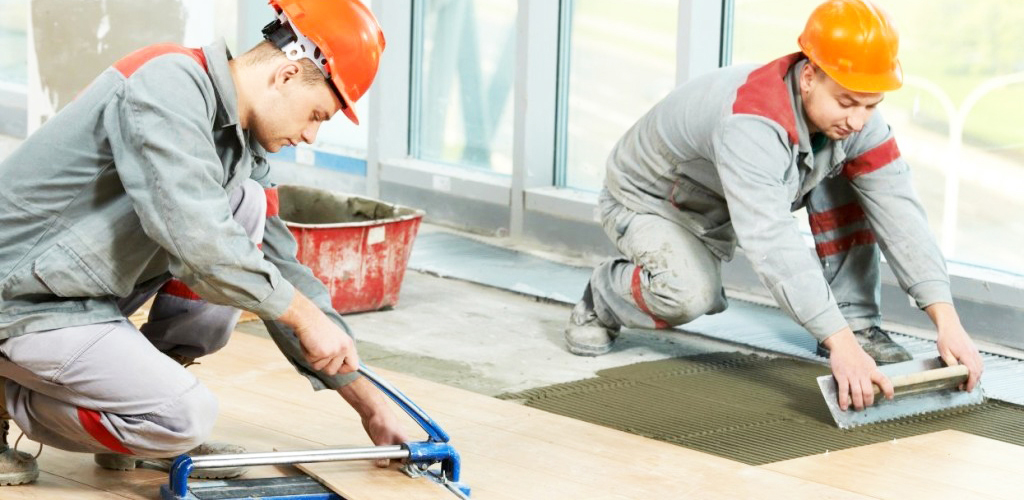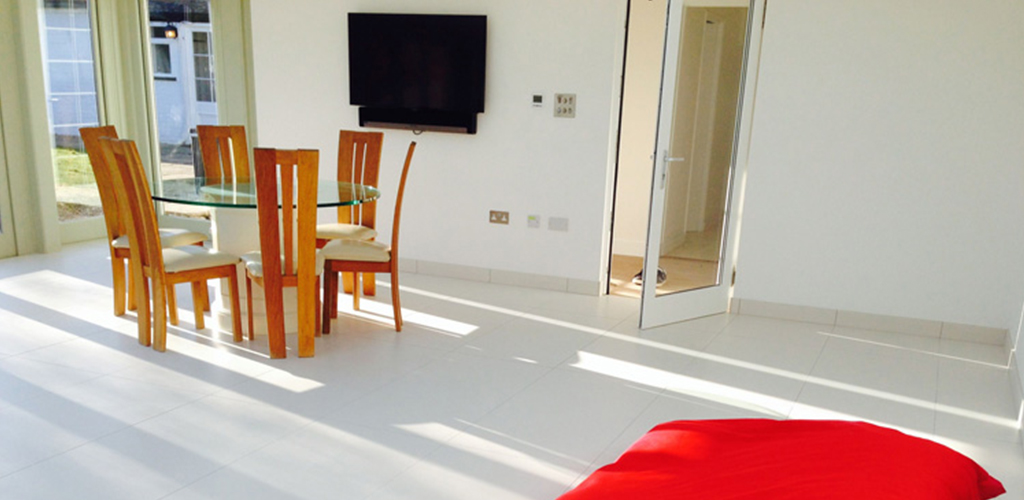Floor covering is a term to generically describe any finish material applied over a floor structure to provide a walking surface. Both terms are used interchangeably but floor covering refers more to loose-laid materials. Materials almost always classified as flooring include carpet, laminate, tile and vinyl.
The floor under the flooring is called the subfloor, which provides the support for the flooring. Special purpose subfloors like floating floors, raised floors or sprung floors may be laid upon another underlying subfloor which provides the structural strength. Subfloors that are below grade (underground) or ground level floors in buildings without basements typically have a concrete subfloor. Subfloors above grade (above ground) typically have a plywood subfloor.
Responsible for laying floor coverings in establishments such as buildings, restaurants, homes, offices, ad factories. Uses various materials, including laminate, linoleum, vinyl, cork, rubber, cement, carpet, wood, or tile.
- Inspect and clean surface in preparation for material.
- Measure area to determine amount of materials needed.
- Confer with architect or homeowner to determine ideal material and layout.
- Correct defects such as a sub-floor that is unleveled or contains rotted wood.
- Sweep, scrape, sand, or chip dirt and irregularities from base surfaces, and fill cracks with putty, plaster, or cement grout to form smooth foundation.
- Order flooring materials.
- Negotiate prices and provide estimates on how long the job will take.
- Cut flooring materials.
- Use adhesive to glue material to floor.
- Unroll and install polyethylene film.
- Install padded underlayer to reduce noise.
- Install floor covering and ensure there are no cracks.
- Clean up leftover adhesives.
- Mop up floors and inspect finished product for flaws.
- Replace any defective flooring material.
- Supervise flooring assistants.
- Work with carpenters, carpet installers, architects, engineers, and other workers to get appropriate job specs.
Main Flooring Categories:
-
Carpeting
Carpet is a soft floor covering made of bound carpet fibers or stapled fibers. Carpeting refers to wall-to-wall coverage, whereas a rug is simply used to cover a space. This type of flooring is typically used indoors and can be used in both high and low traffic areas. It typically lasts for 15-18 years before it needs to be replaced. The quality of a carpet is usually measured in face weight, or how many fibers there are per square inch. The higher the face weight the more plush a carpet will feel.
Carpets come in a variety of materials including wool, nylon, olefin and polyester.
There are different types of carpet like twists, which is commonly referred to as a berber. Twist carpeting is composed of multiple twisted fibers set into the carpet backing. It is typically used in low traffic areas. Another type of carpeting is looped carpets, which are composed of looped fibers set into the carpet backing. This type of carpeting is typically used in high traffic areas as it is easy to clean.
Carpet padding
Padding can be placed underneath the carpet to add comfort and provide some noise insulation. The level of comfort is determined by the type of material used, which can include memory foam and rubber regrind.
Wood flooring
Many different species of wood are fabricated into wood flooring in two primary forms: plank and parquet. Hardwoods are typically much more durable than softwoods. Reclaimed lumber has a unique appearance and is used in green (environmentally responsible) building.
Engineered hardwood has a thin solid wood layer on top with a composite core. It can be a less expensive option than buying hardwood, but it cannot be sanded and refinished. This flooring typically is installed with a click-lock method.
Bamboo flooring is a floor manufactured from the bamboo plant and is a type of hardwood flooring, though technically not a wood. Bamboo is known to be durable and environmentally friendly. It is available in many different patterns, colors, and textures.
Cork flooring is a flooring material manufactured from the by-product of the cork oak tree. Cork floors are considered to be eco-friendly since the cork oak tree bark is stripped every nine to ten years and doesn’t damage the tree. Cork flooring comes in both tiles and planks, and can have glue or glues-less installation.
Laminate
Laminate is a floor covering that appears similar to hardwood but is made with a plywood or medium density fiberboard (“MDF”) core with a plastic laminate top layer. HDF laminate consists of high density fiberboard topped by one or more layers of decorative paper and a transparent protective layer. Laminate may be more durable than hardwood, but cannot be refinished like hardwood. Laminate flooring is available in many different patterns which can resemble different woods or even ceramic tile. It usually locks or taps together. Underlayment is required for laminate flooring to provide moisture and noise control.
Hard flooring
Hard flooring (not to be confused with “hardwood”) is a family of flooring materials that includes concrete or cement, ceramic tile, glass tiles, and natural stone products.
Ceramic tile are clay products which are formed into thin tiles and fired. Ceramic tiles are set in beds of mortar or mastic with the joints between tiles grouted. Varieties of ceramic tiles include quarry tile, porcelain, terracotta.
Many different natural stones are cut into a variety of sizes, shapes, and thicknesses for use as flooring. Stone flooring uses a similar installation method to ceramic tile. Slate and marble are popular types of stone flooring that requires polishing and sealing. Stone aggregates, like Terrazzo, can also be used instead of raw cut stone and are available as either preformed tiles or to be constructed in-place using a cement binder.
Porcelain stoneware can be used instead of natural stone. It is a ceramic material like a tile; however, it is typically 20 mm (0.79 in) thick and often comes in squares of 60 cm (24 in).
Concrete or cement finished floor is also used for its ability to be treated for different feel and its durability, such as polished concrete. Epoxy resurfacing of concrete flooring is used to update or upgrade concrete floor surfaces in commercial and residential applications – see seamless polymer flooring section below.
Floating tile flooring, also called modular tile flooring, includes a range of porcelain and ceramic tile products that can be installed without adhesive or mortar. Generally, the tile is rectified to precise dimensions, and fused to an interlocking base. Some products require use of a flexible grout and others have an integrated grout strip. The advantages include speed of installation, ease of use, reusability, and low cost relative to using traditional tile installation methods.
Resilient flooring
Greatmats Garage Floor Tile Diamond is one form of modular polypropylene flooring tiles intended for garages and other automotive areas.
Unlike ceramic and stone tiles, which are made of minerals, resilient flooring is made of materials that have some elasticity, giving the flooring a degree of flexibility called resilience. Performance surfaces used for dance or athletics are usually made of wood or resilient flooring.
Resilient flooring includes many different manufactured products including linoleum, sheet vinyl, vinyl composition tile (VCT), cork (sheet or tile), and rubber.
Vinyl flooring is available in large sheets or pre-cut tiles; the former is resilient. Some come with a pre-applied adhesive for peel-and-stick installation, others require adhesive to be spread on to the substrate.
The two basic categories of vinyl floor tiles are solid vinyl and vinyl composition, and the three basic categories of vinyl sheet flooring are homogeneous, inlaid, and layered composite. These types of vinyl flooring differ in manufacturing process and content, ranging in vinyl (polyvinyl chloride) content from 11% to 55%.
Resilient flooring products, such as PVC and polypropyleneare becoming more popular in specialty applications such as trailer flooring and garage flooring. New applications have also emerged for marine flooring. There are important factors to consider in specialty applications, that may not be present in a typical application. For example, certain tires will leave marks on PVC flooring but those marks will be less prevalent on polypropylene products. Adhesives also change based on application.
Seamless polymer flooring
-
They find use in situations ranging from the simple protection of domestic garage floors, to the restoration and protection of commercial and industrial flooring. They are also used to solve a vast array of problems in industry such as wet areas in laboratories or food processing plants where spillages of oils and fats are easily absorbed and difficult to clean. Other reasons for covering concrete with a synthetic resin flooring are for improving resistance to chemicals, enhancing resistance to impact and wear, and for aesthetic appearance purposes.Many different seamless flooring materials are available that vary from air drying latex emulsion polymers to reactive thermoset resins such as waterborne, solvented or solvent-free urethanes, polyaspartics and epoxies.[7] Applied in liquid form, all dry and/or cure to provide a completely seamless floor covering.
Seamless polymer flooring can take many forms:
- Floor seals applied at less than 6 mil (0.15 mm)
- Floor coatings applied at 6 – 12 mil (0.15 – 0.3 mm)
- High-build floor coatings applied at 6 – 40 mil (0.15 – 1 mm)
- Broadcast flooring with embedded aggregate applied in excess of 80 mil (2 mm)
- Flow applied (self-smoothing/self-levelling flooring) applied at 80 – 120 mil (2 – 3 mm)
- Trowel finished bound resin screed flooring applied in excess of 160 mil (4 mm)
- Heavy duty flow applied flooring applied at 160 – 240 mil (4 – 6 mm)
- Heavy duty trowel finished resin screed flooring applied in excess of 240mil (6 mm).


